| کد مقاله | کد نشریه | سال انتشار | مقاله انگلیسی | نسخه تمام متن |
|---|---|---|---|---|
| 6245033 | 1609785 | 2012 | 6 صفحه PDF | دانلود رایگان |

PurposeWe evaluated the rate of successful characterization of gastroenteropancreatic neuroendocrine tumors (NETs) present with an increased somatostatin receptor, comparing CE-CT with CE-MRI, each in correlation with DOTATOC-PET.Methods and materials8 patients with GEP-NET were imaged using CE-MRI (Gd-EOB-DTPA), CE-CT (Imeron 400) and DOTATOC-PET. Contrast-enhancement of normal liver-tissue and metastasis was quantified with ROI-technique. Tumor delineation was assessed with visual-score in blind-read-analysis by two experienced radiologists.ResultsOut of 40 liver metastases in patients with NETs, all were detected by CE-MRI and the lesion extent could be adequately assessed, whereas CT failed to detect 20% of all metastases. The blind-read-score of CT in arterial and portal phase was median â0.65 and â1.4, respectively, and 2.7 for delayed-MRI. The quantitative ROI-analysis presented an improved contrast-enhancement-ratio with a median of 1.2, 1.6 and 3.3 for CE-CT arterial, portal-phase and delayed-MRI respectively.ConclusionLate CE-MRI was superior to CE-CT in providing additionally morphologic characterization and exact lesion extension of hepatic metastases from neuroendocrine tumor detected with DOTATOC-PET. Therefore, late enhanced Gd-EOB-DTPA-MRI seems to be the adequate imaging modality for combination with DOTATOC-PET to provide complementary (macroscopic and molecular) tumor characterization in hepatic metastasized NETs.
Journal: European Journal of Radiology - Volume 81, Issue 10, October 2012, Pages 2820-2825